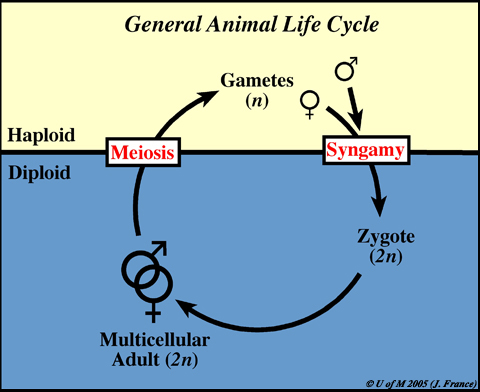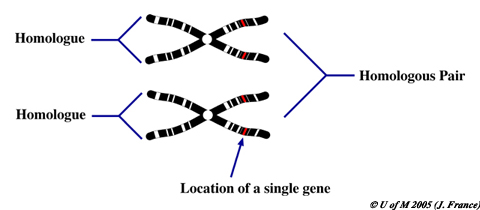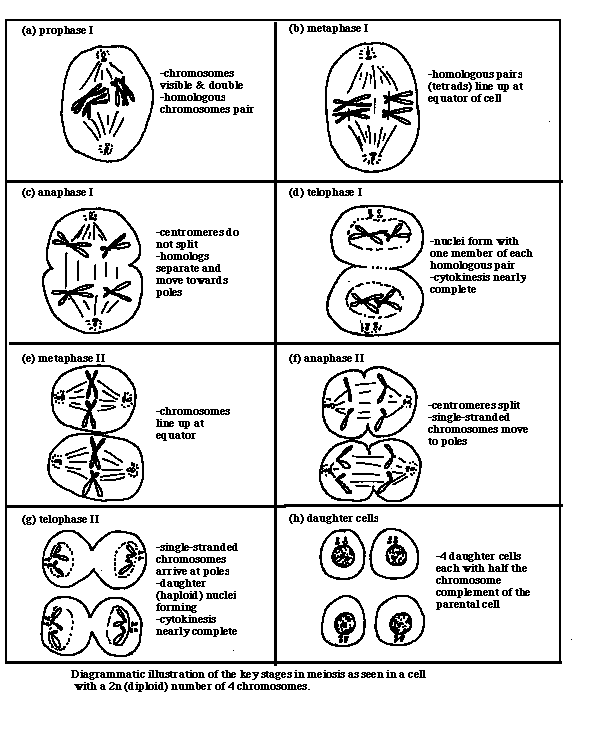
We have examined mitosis as a type of cell division responsible for growth, repair of tissues and in some cases the formation of new organisms. The significant feature of mitosis was that the chromosome number did not change during the division so that the daughter cells carried the same number of chromosomes as the parent cell. Mitotic division leads to a clonel population of cells. Each of the cells produced is genetically identical. Meiosis on the other hand results in daughter cells with half the chromosome number of the parent cell and is thus often referred to as a reduction division. The overall basic pattern is shown in the following illustration.
Meiosis
(Canadina Campbell 2nd ed - Concept 13.2)
In contrast, meiosis results in daughter cells with half the chromosome number of the parent cell and is thus often referred to as a reduction division. The basic overall pattern is shown in the following illustration:

In this way, after completing meiosis, a 46 chromosome human cell has been reduced to four daughter cells, each with 23 chromosomes. In animals, meiosis is directly responsible for the production of sex cells or gametes. In plants, meiosis leads to a haploid stage, the spore, which later gives rise to a multicellular haploid gametophyte, which in turn produces gametes.
A general animal life cycle, including meiosis is shown below:

Eventually a mating process leads to the fusion of male and female gametes resulting in a cell known as a zygote. The zygote will have the 2n or diploid chromosome number in its nucleus. Development of the zygote through mitosis results in the formation of the mature organism.
Meiosis involves two division sequences in succession which ultimately results in the formation of four new cells, each of which is haploid. In order to appreciate the significance of the meiotic division you will have to understand the meaning of terms like somatic cell, gamete, diploid and haploid number, and homologous chromosomes. (See your lecture notes and text).

During meiosis the 46 chromosomes (the diploid number) are separated into four
sets of 23 (the haploid number) with each set containing one member of the matching
pair. In other organisms the main variation on this theme would be in the number
of chromosome pairs present being from as few as 2 pairs up into the hundreds
for some species.
In meiosis there are two divisions in succession. It is the
first division sequence that accomplishes a reduction in the number of chromosomes;
the second division sequence resembles a mitotic one and converts double-stranded
chromosomes to single-stranded. Again, as in mitosis, we can examine the nuclear
events of meiosis.
We can describe these events as prophase, metaphase,
anaphase and telophase. The following figure
gives you a good description of this fundamental process. Examine it closely.
Also examine Table 2 from your lab manual very closely because you should know
the similarities and differences between these two fundamental biological processes.
After you have examined and thought about these two methods of cell division
ask your laboratory demonstrator or a professor to help you solve any difficulties.
The first division sequence (meiosis I) results in a reduction in the number of chromosomes and is therefore referred to as the reduction division; the second division sequence resembles a mitotic one and converts the remaining double-stranded chromosomes to single-stranded.

First published Sept 95: Modified June 2020
Copyright © Michael Shaw 2019 (Images and Text)
![]() Back
to Lab Index
Back
to Lab Index ![]() Forward
to Next Page
Forward
to Next Page ![]() University
of Manitoba Home
University
of Manitoba Home